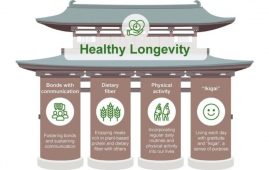

According to new American Cancer Society guidelines, more current and past smokers should begin undergoing yearly lung cancer screening.
According to new guidelines published in CA: A Cancer Journal for Clinicians, people 50 to 80 years old who smoked the equivalent of one pack of cigarettes per day for at least two decades should have annual screenings with a type of X-ray known as a low-dose computed tomography (CT) scan, whether they are current or former smokers.
Under previous guidelines, people needed screening only from ages 55 to 74 if they smoked the equivalent of a pack a day for at least three decades, and if they were current smokers or had quit within the past 15 years, the American Cancer Society said in a statement.
Earlier lung cancer screening, starting at age 50 instead of age 55, and with less total exposure to cigarettes, expands the people who may need annual lung CT scans to about 14.3 million from about 8.1 million previously, says Robert Smith, PhD, the lead author of the new guidelines and the senior vice president for early cancer detection science at the American Cancer Society (ACS).
“This updated guideline continues a trend of expanding eligibility for lung cancer screening in a way that will result in many more deaths prevented by expanding the eligibility criteria for screening to detect lung cancer early,” Dr. Smith says. “Recent studies have shown extending the screening age for persons who smoke and formerly smoked, eliminating the ‘years since quitting’ requirement and lowering the pack per year recommendation could make a real difference in saving lives.”
What Are ‘Pack-Years’ of Smoking Cigarettes?
The ACS based its recommendations on pack years, an established method of measuring cumulative cigarette exposure. One pack-year is the equivalent of smoking a full pack of cigarettes every day for a year.
Someone who has smoked 20 pack years may have smoked a pack a day for two decades, or two packs everyday for ten years.
“The guideline has always focused on people who currently smoke or formerly smoked, as long as they had the requisite pack-year history,” Smith says.
While it’s true that the risk of lung cancer is lower when people smoke less and quit sooner, the risk created by a 20 pack-year history is still high enough to warrant years of screening, Smith adds. “They will have built up considerable risk, and their quit date is less important than the cumulative exposure to tobacco smoke,” Smith says.
More People Will Get Screened if the ‘Years Since Quitting’ Requirement Is Removed
One advantage of removing any reference to years since quitting from the recommendations is that it will be easier for people to understand whether the recommendations apply to them, says Michael Ong, MD, PhD, a professor at UCLA and internal medicine doctor who is also affiliated with the VA Greater Los Angeles Healthcare System and the UCLA Jonsson Comprehensive Cancer Center.
“It is a simpler message regarding screening if there is not a caveat about the time since quitting,” Dr. Ong says. “Eliminating the years since quitting will increase the number of individuals who get screened, increase the number of lung cancers detected, and reduce the mortality from lung cancer.”
But there are some potential downsides to expanding the number of people who get screened, Ong cautions. This would increase the number of people who get so-called false-positive screening results, meaning the tests show a problem where none exists. This, in turn, can lead to unnecessary and often invasive tests and treatments.”
Who Should Not Get Screened for Lung Cancer
To reduce the possibility that the risks of screening outweigh the benefits, the revised guidelines emphasize that persons with health issues that severely restrict their life expectancy and ability or willingness to receive cancer therapies should not be screened.
“We would not recommend screening to adults younger than age 50, or with less than a 20 pack-year history of smoking.” Smith says. We also do not recommend lung cancer screening in individuals with life-limiting comorbidity or less than five years’ expected longevity.”
For more information:
Screening for Lung Cancer: 2023 Guideline Update From the American Cancer Society. CA: A Cancer Journal for Clinicians.
What Are Pack-Years? University of Colorado Cancer Center.
more recommended stories
 High-Intensity Training and Oxidative Stress Insights
High-Intensity Training and Oxidative Stress InsightsNew Evidence Linking High-Intensity Training and.
 Perinatal Mental Health Challenges Highlighted in New Study
Perinatal Mental Health Challenges Highlighted in New StudyMental Health Challenges in New Parents:.
 World Summit Outlines Core Principles for Healthy Longevity
World Summit Outlines Core Principles for Healthy LongevityWhy Healthy Longevity Demands a New.
 Cholesterol-Lowering Drugs May Help Reduce PFAS Levels
Cholesterol-Lowering Drugs May Help Reduce PFAS LevelsPer- and polyfluoroalkyl substances (PFAS) continue.
 AI ECG Model Outperforms Standard STEMI Triage
AI ECG Model Outperforms Standard STEMI TriageNovel AI ECG Model Outperforms Standard.
 WHO and EU Strengthen Digital Health in Africa
WHO and EU Strengthen Digital Health in AfricaThe World Health Organization (WHO) and.
 Quitting Smoking Slows Memory Decline, Study Finds
Quitting Smoking Slows Memory Decline, Study FindsQuitting smoking is linked to slower.
 Breakfast Skipping Linked to Metabolic Syndrome
Breakfast Skipping Linked to Metabolic SyndromeBreakfast Skippers May Face Metabolic Consequences.
 Cancer Cells Learn to Self-Report: A New Frontier in Immunotherapy
Cancer Cells Learn to Self-Report: A New Frontier in ImmunotherapyHow a Drug Complex Enables Immune.
 Machine Learning Predicts Early Mortality in IBD Patients
Machine Learning Predicts Early Mortality in IBD PatientsA groundbreaking study published in the.

Leave a Comment